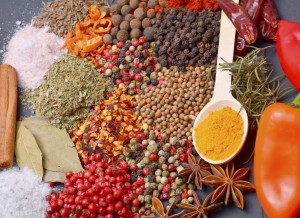The term “spice” is defined in the U.S. Code of Federal Regulations for specific labeling requirements. “Spice” is defined under 21 CFR Sec. 101.22(2) (2) The term spice means any aromatic vegetable substance in the whole, broken, or ground form, except for those substances which have been traditionally regarded as foods, such as onions, garlic and celery; whose significant function in food is seasoning rather than nutritional; that is true to name; and from which no portion of any volatile oil or other flavoring principle has been removed. Spices include the spices listed in 182.10 and part 184 of this chapter, such as the following: Allspice, Anise, Basil, Bay leaves, Caraway seed, Cardamon, Celery seed, Chervil, Cinnamon, Cloves, Coriander, Cumin seed, Dill seed, Fennel seed, Fenugreek, Ginger, Horseradish, Mace, Marjoram, Mustard flour, Nutmeg, Oregano, Paprika, Parsley, Pepper, black; Pepper, white; Pepper, red; Rosemary, Saffron, Sage, Savory, Star aniseed, Tarragon, Thyme, Turmeric. Paprika, turmeric, and saffron or other spices which are also colors, shall be declared as “spice and coloring” unless declared by their common or usual name. “Spice” as permitted in labeling for flavors in the statement of ingredients (h) The label of a food to which flavor is added shall declare the flavor in the statement of ingredients in the following way: (1) Spice, natural flavor, and artificial flavor may be declared as “spice”, “natural flavor”, or “artificial flavor”, or any combination thereof, as the case may be.
21 CFR Sec. 182.10 Spices and other natural seasonings and flavorings






